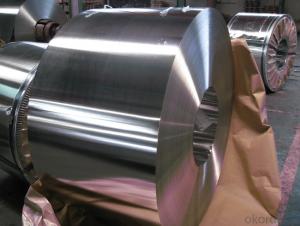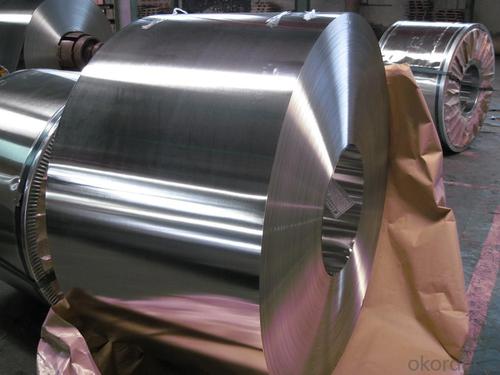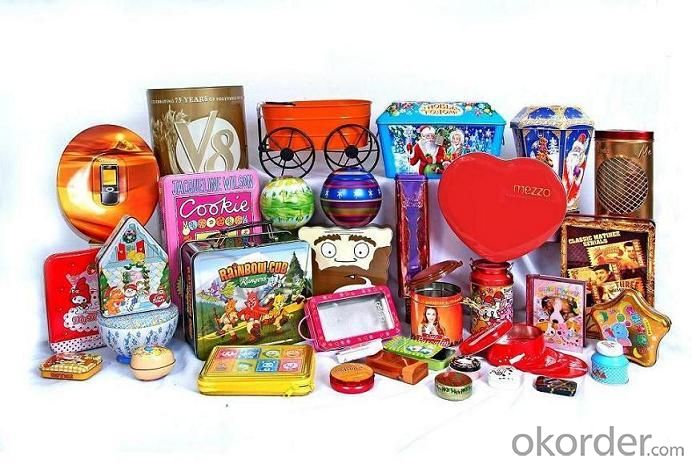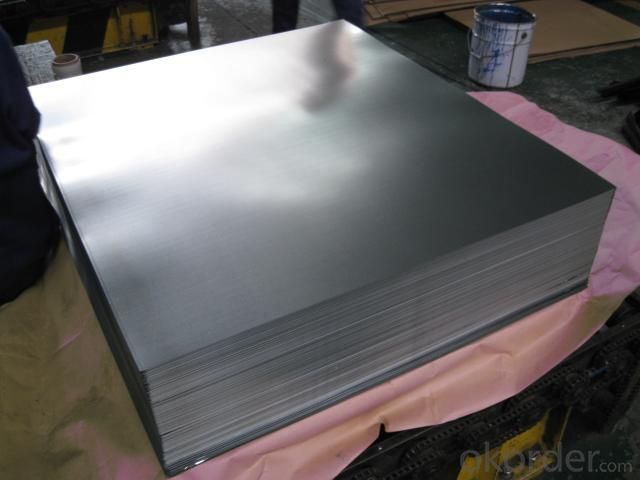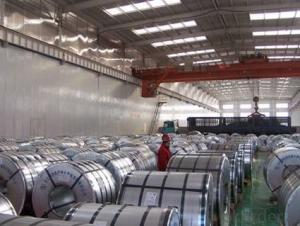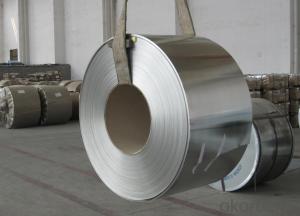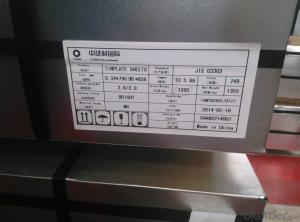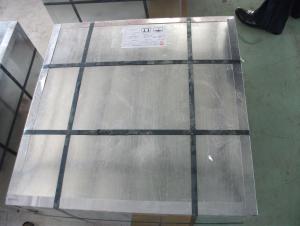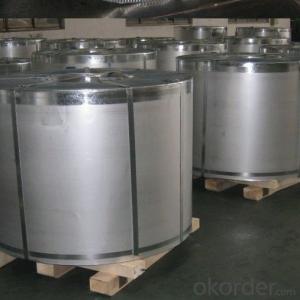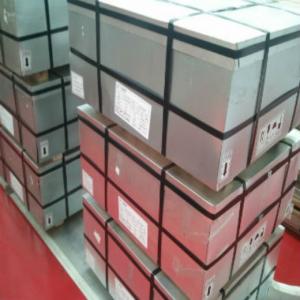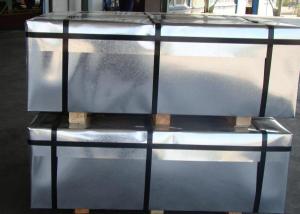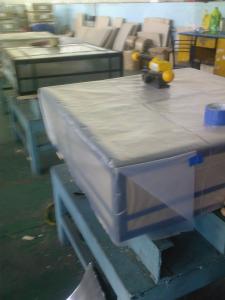Tinplate for Paint Drums, Prime Grade/Secondary Grade
- Loading Port:
- China main port
- Payment Terms:
- TT OR LC
- Min Order Qty:
- 25 m.t
- Supply Capability:
- 40000 m.t/month
OKorder Service Pledge
OKorder Financial Service
You Might Also Like
Specification
1.Usage
Tinplate is widely used for making all types of containers, containing industrial usage such as paint can, oil can, aerosol cans etc., and food cans like milk powder cans, tomato paste can, dry food cans etc.
2. Specification
standard: GB/T2520, JIS G3303, DIN EN10202
Material: MR /SPCC
Thickness available: 0.16-0.50MM
Width available: 600~1050MM
Temper grade: T1 – DR8
Tin coating: ordinary 2.8g/2.8g, 5.6g/5.6g and others
Package: sea worthy export package.
Applications: Tin can for chemicals & paint cans, industrial cans, food cans
3. Our CA Line Production Range
Temper | Thickness(mm) | Width(mm) | Length(mm) |
T3CA | 0.19~0.20 | 800~900 | 520~1068 |
0.21~0.25 | 800~950 | ||
0.26~0.45 | 800~1050 | ||
T4CA | 0.17~0.20 | 800~950 | |
0.20~0.45 | 800~1050 | ||
T5CA | 0.17~0.20 | 800~950 | |
0.20~0.28 | 800~1050 |
4. Our factory photo & equipments

5. FAQ
a. what’s your company name?
our company named CNBM international corporation, we are both one large state owned company and tinplate supplier in China
b. where your mill situated?
Our head office is in Beijing, while our mill in Hebei province.
c. how about the delivery time?
usually 55~65 days after receipt advance payment or original LC;
d. what payment term you accept?
Our payment term is very feasible, such as TT, DP, LC at sight, LC after sight etc.
e. can you offer MTC?
Of course, we will issue MTC after each shipment, for customer reference and testing if some quality issue appears.
- Q: How does tinplate perform in terms of resistance to chemical agents?
- Tinplate generally exhibits good resistance to chemical agents due to the protective layer of tin coating. This coating acts as a barrier, preventing direct contact between the metal and the chemicals, thereby minimizing the risk of corrosion or chemical reactions. However, the specific performance can vary depending on the type and concentration of the chemical, as well as the duration of exposure.
- Q: What are the main applications of tinplate in the tobacco industry?
- The main applications of tinplate in the tobacco industry include the production of cigarette packaging, such as cigarette boxes and tins. Tinplate offers excellent protection against moisture, light, and air, helping to preserve the quality and freshness of tobacco products. Additionally, tinplate's durability and malleability make it ideal for creating intricate designs and embossing, enhancing the aesthetic appeal of tobacco packaging.
- Q: What are the main factors influencing the demand for tinplate?
- The main factors influencing the demand for tinplate include the growth in the packaging industry, consumer preferences for canned goods, economic development in emerging markets, and environmental regulations promoting sustainable packaging.
- Q: How does tinplate handle exposure to light?
- Tinplate handles exposure to light quite well. Due to its metallic properties, tinplate is not affected by light in terms of discoloration or degradation. It does not absorb light and is not prone to fading or yellowing. Therefore, tinplate can maintain its appearance and integrity even when exposed to light for extended periods.
- Q: What are the different types of tinplate lamination?
- There are two main types of tinplate lamination: single-sided lamination and double-sided lamination. Single-sided lamination involves laminating one side of the tinplate with a layer of material, while the other side remains untreated. Double-sided lamination, on the other hand, involves laminating both sides of the tinplate with different layers of material, providing enhanced protection and durability.
- Q: What is the tensile strength of tinplate?
- The tensile strength of tinplate typically ranges from 180 to 220 megapascals (MPa).
- Q: Can tinplate packaging be used for electronic products?
- Yes, tinplate packaging can be used for electronic products. Tinplate is a durable and corrosion-resistant material that provides effective protection for electronic devices. It can be customized to fit various shapes and sizes, ensuring a secure and reliable packaging solution for electronic products. Additionally, tinplate packaging can also enhance the aesthetic appeal of electronic products, making them more visually appealing to consumers.
- Q: What are the safety regulations for using tinplate in toys?
- The safety regulations for using tinplate in toys may vary depending on the country or region. However, in general, these regulations typically include guidelines for lead content, sharp edges, choking hazards, and other potential risks associated with the use of tinplate in toys. It is important for manufacturers and suppliers to comply with these regulations to ensure the safety of children who use the toys.
- Q: How does tinplate handle exposure to chemicals and solvents?
- Tinplate is generally resistant to exposure to chemicals and solvents due to its protective tin coating, which acts as a barrier against corrosion and chemical reactions. This makes tinplate a reliable choice for packaging and storing various products that may come into contact with different chemicals and solvents.
- Q: What are the potential health risks associated with tinplate?
- The potential health risks associated with tinplate are primarily related to the potential transfer of tin or other heavy metals into food or beverages stored in tinplate containers. Prolonged exposure to high levels of tin or other heavy metals may lead to various health issues, including gastrointestinal problems, kidney damage, and neurological disorders. However, the health risks are generally low when tinplate is used in accordance with safety regulations and proper storage and handling practices are followed.
Send your message to us
Tinplate for Paint Drums, Prime Grade/Secondary Grade
- Loading Port:
- China main port
- Payment Terms:
- TT OR LC
- Min Order Qty:
- 25 m.t
- Supply Capability:
- 40000 m.t/month
OKorder Service Pledge
OKorder Financial Service
Similar products
Hot products
Hot Searches
Related keywords
